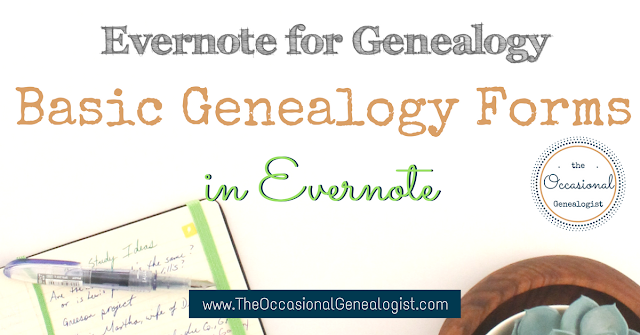Genealogists are notorious paper users. I would love to have a completely paper-free office, and I've worked toward that.
Still, when I use paper, I often use a lot. At the moment, the wall next to my desk is covered in pedigree charts for a select group of my atDNA matches. I did a pretty good job of reducing the paper needed for that project, but I really did feel I needed paper (see this post for tips on reducing paper when you have to print).
Find more Evernote genealogy templates we created by clicking here. (All the templates are now accessible as part of our free Resource Library).

In this post, learn to use our simple and customizable genealogy "forms" for Evernote.
- 5-generation pedigree chart (also called a family tree)
- Family Group Sheet
- + some Evernote tips (and more available freebies)
Evernote Genealogy Templates
The forms include a five-generation pedigree chart and a very basic family group sheet or family summary. All of the Evernote "templates" are available in our free Resource Library.
Customizable Genealogy Forms in Evernote
Part of the reason these forms are in Evernote is to allow you to customize them easily. The pedigree chart probably requires less customization but requires the formatting to remain consistent. The family group sheet can be customized as much or as little as you want.
So here are some suggestions for using these forms. There isn't a right or wrong answer, though. I tried to keep these simple, so you had plenty of choices.
Pedigree Chart
This is a very basic pedigree chart. Evernote gives you almost no formatting options for a table, so there weren't a lot of choices, anyway. The easiest way to create a pedigree chart is from genealogy software. If you are going to type it manually, such as with this form, there should be a good reason. I would use the pedigree chart as a formatted table of contents or cross-reference. I would put in links, so the chart is functional, not just something to see five generations at a glance. The links could be to anything you want but to the appropriate family group sheet would be an easy, consistent option.
Family Group Sheet
This is the most basic family group sheet I could create. When I started genealogy, I recorded all my research findings on pedigree charts and family group sheets (I obviously took notes, too). This ended up giving me tunnel vision; I focused on what fit on my family group sheet.
The only reason I overcame the tunnel vision was my desire to learn more. When I was finally able to learn more, I went crazy and learned everything I could. It was like going from 1st grade to high school. The jump sort of "reset" my genealogical thinking.
Because of my experience, I don't want to provide something that will give you tunnel vision and leave you stuck in the 1st grade (unknown to you) for years.
Once again, you can use links in this form so it can be a cross-reference. You may also want to use it as a very basic summary. Your other option is to expand it and make it fully customized.
If you are thinking of additional pieces of information to put on your family group sheet (as opposed to copying a standard form), tunnel vision isn't a problem. You're just using a form instead of writing a report.
FYI, your family group sheet cannot take the place of a report or memo. It can be the part that presents the names, dates, and place (with sources). You still need to be able to record narrative ideas (instead of "facts") such as issues you've encountered.
That's all I'm going to say about reporting. There are lots of articles online to help you learn more and find offline resources, as well. Just realize that the family group sheet is not where your genealogy ends.
Evernote Tip
If you want a cross-reference, here is an idea. Evernote allows you to create saved searches, however, it doesn't appear you can create a link to those searches (on the desktop versions they can be added to your "shortcuts" but I'm talking about a link within a note just as you can link from one note to another).
Saved searches are just advanced searches that you can choose from the search bar instead of retyping. If you have multiple notes you want "linked" to one item on your family group sheet (or any cross-reference note), just copy and paste the search text to the note. You will then copy and paste it to the search bar when you need it.
It would be nice if saved search links would become an option in Evernote and they might at some point. This is a workaround that should work now and on any Evernote platform. Using this technique can also help you think about how you want to organize your genealogy in Evernote. You want an efficient combination of notebooks and tags to pull up a select group of notes.
Both of these forms used to be the standards for a beginning genealogist. I'm not sure how much they are used now that there are many options for free online trees.
If you are recording your research results in Evernote, a pedigree chart, and a family group sheet can be good organizational tools. On paper, they summarized findings. Electronically they can be a table of contents to everything else you've recorded, found, or kept on a research subject.









